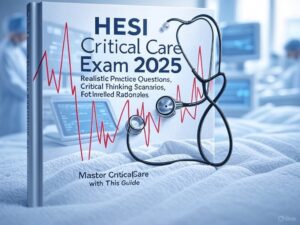-
Realistic practice questions aligned with the 2025 HESI exam
-
Critical thinking scenarios to enhance decision-making
-
Detailed rationales for every question to deepen understanding
-
Covers key critical care concepts for nursing students
-
Ideal for HESI Critical Care Exam preparation
Preview
A female client makes routine visits to a neighborhood community health center. The
nurse notes that this client often presents with facial bruising, particularly around the
eyes. The nurse discusses prevention of domestic violence with the client even though the
client does not admit to being battered. What level of prevention has the nurse applied in
this situation? A. Health promotion.
B. Primary prevention.
C. Secondary prevention.
D. Tertiary prevention. – – correct ans- -C. Secondary prevention.
RATIONALE:
Secondary prevention (B) attempts to halt the progression of the disease process, in this
case, an escalation in the battering, by educating the client about prevention strategies.
The nurse has identified client injuries that create a suspicion of battering and domestic
violence. (A) would be activities that occur before the disease process begins, such as
providing community seminars on the risks, and signs and symptoms of domestic violence.
(C) occurs after the disease process has
started, and includes referring the client to a battered women’s shelter for treatment
following unabated, chronic abuse. Health promotion can be incorporated in all levels of
prevention (D).
A primipara with a breech presentation is in the transition phase of labor. The nurse
visualizes the perineum and sees the umbilical cord extruding from the introitus. In which
position should the nurse place the client?
A. Right lateral side with both legs flexed.
B. Left supine with thighs flexed on her abdomen.
C. Semi-Fowler’s with head of bed elevated 30 degrees.
D. Supine with the foot of the bed elevated. – – correct ans- -D. Supine with the foot of the
bed elevated.
RATIONALE:
The supine position with the foot of the bed elevated (D) (Trendelenburg) is one position
used to
alleviate gravitational pressure by the fetus on the prolapsed umbilical cord, (A, B, and C)
do not alleviate pressure on the umbilical cord.
The nurse is developing a series of childbirth preparation classes for primigravida
women and their significant others. What is the priority expected outcome for these
classes?
A. Educate significant others about providing support for their partner during labor.
B. Teach and practice breathing techniques to help cope with contractions during labor.
C. Participants can identify at least three coping strategies to use during labor.
D. Introduce comfort measures that are effective techniques to use during labor and
delivery. – – correct ans- -C. Participants can identify at least three coping strategies to use
during labor.
RATIONALE:
An expected outcome is a specific, measurable change in a client’s status that occurs in
response to nursing interventions. (B) meets the criteria for an expected outcome. (A, C,
and D) are nursing interventions that should lead to the expected outcome.












Reviews
There are no reviews yet.